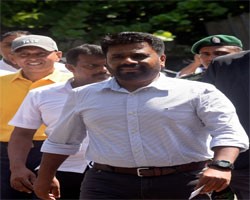SSC Current Affairs
| International Relations |
|---|
|
|
|
Why in the news?
Sri Lankan President Anura Kumara Dissanayake will visit India from December 15 to 17, the Foreign Ministries of the two countries said, announcing his first state visit abroad since he won the Presidency in September and his party swept the polls in the November general elections. Key Takeaways: 📍During his visit, President Disanayaka will meet Rashtrapati Ji and hold discussions with Prime Minister Shri Narendra Modi on bilateral issues of mutual interest. 📍President Disanayaka will also participate in a business event in Delhi to promote investment and commercial linkages between India and Sri Lanka. Further, he will visit Bodh Gaya as part of the visit. 📍Sri Lanka is India’s closest maritime neighbour in the Indian Ocean Region (IOR) and holds a central place in Prime Minister’s vision of ‘SAGAR’ (Security and Growth for All in the Region) and India’s ‘Neighbourhood First’ policy. 📍The visit of President Disanayaka to India is expected to further strengthen the multi-faceted and mutually beneficial cooperation between the two countries. About Mahabodhi Temple Complex: The Maha Bodhi Temple Complex is one of the four holy sites related to the life of the Lord Buddha, and particularly to the attainment of Enlightenment (Bodhi). It is located in Bodh Gaya, in central Bihar, on the banks of the Niranjana River. The other three are: Lumbini (Birth) in Nepal, Sarnath (Dharma-Chakra-Pravartana - 1st Sermon) and Kushinagar (Mahaparinirvana- death) in Uttar Pradesh. The first temple was built by Emperor Asoka in the 3rd century B.C., and the present temple dates from the 5th or 6th centuries. It is one of the earliest Buddhist temples built entirely in brick, still standing from the late Gupta period, and it is considered to have had a significant influence in the development of brick architecture over the centuries. The sculpted stone balustrades are an outstanding early example of sculptural reliefs in stone. It was recognized as a UNESCO World Heritage Site in 2002. Features: The present Temple Complex comprises the 50-meter-high grand Temple, six sacred places within an enclosed area, and a seventh one, the Lotus Pond, just outside the enclosure to the south. The most important of the sacred places is the giant Bodhi Tree. This tree is to the west of the main temple and is supposed to be a direct descendant of the original Bodhi Tree, under which the Buddha had his enlightenment. Ashoka’s stone slab purporting to mark the exact position where the Buddha sat is traditionally called the Buddha’s vajrasana (literally “diamond throne” or “thunder seat”). The grand temple’s pyramidal shikhara (tower) comprises several layers of niches, arch motifs, and fine engravings. Four towers, each identical to its central counterpart but smaller in size and topped with an umbrella-like dome, adorn the corners of the two-story structure. A shrine inside the temple holds a yellow sandstone statue of the Buddha encased in glass. The 4.8-hectare (11.9-acre) complex also includes ancient shrines and modern structures built by Buddhist devotees. SAGAR: Security and Growth for All in the Region (SAGAR) was launched in 2015. It is India’s strategic vision for the Indian Ocean Region (IOR). Through SAGAR, India seeks to deepen economic and security cooperation with its maritime neighbours and assist in building their maritime security capabilities. Further, India seeks to safeguard its national interests and ensure Indian Ocean region to become inclusive, collaborative and respect international law. The key relevance of SAGAR emerges when seen in conjunction with India’s other policies impacting the maritime domain like Act East Policy, Project Sagarmala, Project Mausam, India as ‘net security provider’, focus on Blue Economy etc. The SAGAR doctrine is defined as follows: Maritime Security Maritime Cooperation Economic Cooperation Capacity Building Sustainable Development Collective Action Neighbourhood First Policy: India’s ‘Neighbourhood First policy’ guides its approach towards the management of relations with countries in its immediate neighbourhood, that is, Afghanistan, Bangladesh, Bhutan, Maldives, Myanmar, Nepal, Pakistan and Sri Lanka. The policy officially came to being in 2008. Aim: The Neighbourhood First policy, inter alia, is aimed at enhancing physical, digital and people to people connectivity across the region, as well as augmenting trade and commerce. This policy has evolved into an institutional priority for all the relevant arms of the Government managing relations and policies with our neighbourhood. |
|
|
|
Useful information for all competitive exams:
Sri Lanka: Sri Lanka, historically known as Ceylon, and officially the Democratic Socialist Republic of Sri Lanka, is an island country in South Asia. Capital: Sri Jayawardenepura Kotte (legislative), Colombo (executive and judicial) Government: Unitary semi-presidential republic President: Anura Kumara Dissanayake Prime Minister: Harini Amarasuriya Currency: Sri Lankan rupee (Rs) (LKR) |
| >> More SSC Current Affairs |
